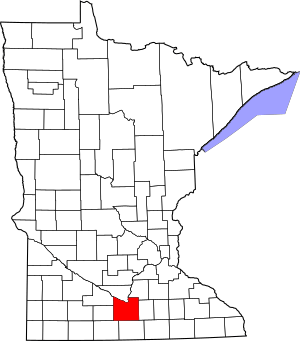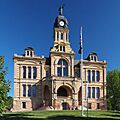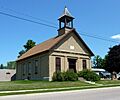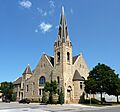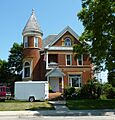National Register of Historic Places listings in Blue Earth County, Minnesota facts for kids
Blue Earth County in Minnesota is home to many cool and important places! These places are listed on the National Register of Historic Places. This is like a special list of buildings, bridges, and areas that are super important to the history of the United States. They are worth protecting and remembering.
There are 28 places in Blue Earth County that are currently on this list. There are also five other places that used to be on the list but are not anymore. Let's explore some of these amazing historic spots!
Contents
- Amazing Historic Places in Blue Earth County
- Cool Buildings You Can Still See
- Blue Earth County Courthouse
- J.R. Brandrup House
- Charles Chapman House
- Lorin Cray House
- Dodd Ford Bridge
- Adolph O. Eberhart House
- Federal Courthouse and Post Office
- First Baptist Church (Garden City)
- First National Bank of Mankato
- First Presbyterian Church (Mankato)
- James P. Gail Farmhouse
- Renesselaer D. Hubbard House
- William Irving House
- Jones-Roberts Farmstead
- Kern Bridge
- Lincoln Park Residential Historic District
- Main Street Commercial Buildings (Mapleton)
- Mankato Public Library and Reading Room
- Mankato Union Depot
- Mapleton Public Library
- Marsh Concrete Rainbow Arch Bridge
- Minneopa State Park WPA/Rustic Style Historic Resources
- North Front Street Commercial District
- Old Main, Mankato State Teachers College
- Seppman Mill
- Sterling Congregational Church
- Lucas Troendle House
- Zieglers Ford Bridge
- Places That Used to Be on the List
- Cool Buildings You Can Still See
- Images for kids
Amazing Historic Places in Blue Earth County
Cool Buildings You Can Still See
Blue Earth County Courthouse
This impressive building was built between 1886 and 1889. It's known for its fancy French and Italian Renaissance style of architecture. For a long time, it has been the main government building for Blue Earth County.
J.R. Brandrup House
Built in 1904, this house is a great example of Neoclassical architecture. It belonged to J.R. Brandrup, who helped start an important school in Mankato. This house is also part of the Lincoln Park Residential Historic District.
Charles Chapman House
This house, built around 1858, belonged to Charles Chapman. He was an early surveyor and city engineer who played a big role in how Mankato first developed.
Lorin Cray House
This beautiful Queen Anne style house was built in the late 1890s. It was the home of Lorin Cray, a kind person who supported many local groups, like the YWCA.
Dodd Ford Bridge
The Dodd Ford Bridge was built in 1901. It's a special type of bridge called a Pratt truss bridge. It was designed by a famous Minnesota bridge engineer, Lawrence H. Johnson. This bridge shows how much the government invested in building new things in Blue Earth County during the Progressive Era (a time of social and political reform).
Adolph O. Eberhart House
This house, built around 1903, was the home of Adolph Olson Eberhart. He was an important politician who served as a state senator, lieutenant governor, and even the governor of Minnesota! This house is also part of the Lincoln Park Residential Historic District.
Federal Courthouse and Post Office
This huge federal building in Mankato was built in 1896. It was made bigger in 1932 and 1965. It's famous for its strong Richardsonian Romanesque style, built with local Mankato limestone.
First Baptist Church (Garden City)
Built in 1868, this church is important because it represents Garden City, which was a very successful community before railroads came to the area. It's also one of the earliest known buildings in Minnesota to use concrete blocks.
First National Bank of Mankato
This bank, built in 1913, is the best example of Prairie School architecture in the region. It was designed by Ellerbe & Round. Today, it's part of the Verizon Wireless Center.
First Presbyterian Church (Mankato)
This impressive Richardsonian Romanesque church was designed by Warren H. Hayes. It was built between 1893 and 1896 using local Mankato limestone.
James P. Gail Farmhouse
This unique Octagon house was built in the late 1850s. It's a rare example of this popular 19th-century house style in rural Minnesota. It reminds us of the first European settlers in the area.
Renesselaer D. Hubbard House
This fancy house was built in 1871. It belonged to Renesselaer D. Hubbard, a very successful businessman who helped Mankato grow a lot. Today, it's a museum where you can learn about history.
William Irving House
This well-preserved Second Empire style house was built in 1873. It belonged to William Irving, an early merchant in Mankato.
Jones-Roberts Farmstead
This farm is a rare reminder of the main Welsh American settlement in Minnesota. It's a well-preserved example of an early farm in Blue Earth County, with buildings from the 1850s to 1887.
Kern Bridge
The Kern Bridge, built in 1873, is Minnesota's only bowstring arch truss bridge. It was the oldest road bridge still in use when it was added to the list. It was closed to cars in 1991.
Lincoln Park Residential Historic District
This is a large and well-preserved neighborhood from the late 1800s and early 1900s. It has 247 important buildings constructed between 1856 and 1930.
Main Street Commercial Buildings (Mapleton)
This block of commercial buildings from the 1890s is known for its consistent design. It shows how "Main Streets" in the region developed around the turn of the 20th century.
Mankato Public Library and Reading Room
This public library was built between 1902 and 1903. It's famous for being a "Carnegie library," which means it was built with money from the rich businessman Andrew Carnegie. It also features Renaissance Revival architecture using local materials.
Mankato Union Depot
Built in 1896, this is the only railway station still standing that was important for the growth of 13 communities in Blue Earth County.
Mapleton Public Library
This library, built in 1910, is another Carnegie library. It shows how people in Minnesota pushed for public libraries, often with help from Andrew Carnegie's generous donations.
Marsh Concrete Rainbow Arch Bridge
This concrete through arch bridge was built in 1911. It's the oldest one of its kind still standing in Minnesota and one of the first built by the Marsh Engineering Company of Iowa.
Minneopa State Park WPA/Rustic Style Historic Resources
This park has 7 important buildings constructed between 1937 and 1940. They are significant examples of federal work relief programs during the New Deal era, early Minnesota state park development, and the rustic design style of the National Park Service.
North Front Street Commercial District
This well-preserved part of Mankato's original business area shows how the city grew economically from the 1870s to the early 1900s. It also shows changes in commercial building styles.
Old Main, Mankato State Teachers College
These are the oldest buildings, built in 1908 and between 1922 and 1924, of a state-run teacher's college started in 1868. They represent school design from the early 1900s and Minnesota's strong commitment to education.
Seppman Mill
This stone windmill was finished in 1863 and is one of the few ever built in Minnesota. It worked until 1890 when a storm destroyed its arms.
Sterling Congregational Church
This simple church, built in 1867, is a rare example of a rural community building from the time before railroads reached Blue Earth County.
Lucas Troendle House
This Queen Anne style house was built in 1896. It belonged to Lucas Troendle, an important local citizen. It shows how successful many people became by investing in land and businesses in the region's railroad towns in the late 1800s.
Zieglers Ford Bridge
This bridge, built in 1904, was a pin-connected Pratt truss bridge, a common type in Minnesota back then. It was one of the few built by a company not from Minneapolis–Saint Paul. It was removed in 1995.
Places That Used to Be on the List
Adam Jefferson House
This Greek Revival style house, built around 1865, belonged to a pioneer in the local quarrying industry. It was moved in 1987 to North Mankato to make way for a quarry expansion.
Kennedy Bridge (Mankato)
This wrought iron Pratt truss bridge was built in 1883. It was moved in 2006.
Mankato Holstein Farm Barn
This barn, built in 1917, was used for breeding dairy cattle. It was torn down in 2006 after its roof collapsed.
Oscar Schmidt House
This Georgian Revival house was built in 1925 and belonged to a well-known business owner. It was torn down in 1988 to make the Mankato YMCA bigger.
Winnebago Agency House
This brick Federal style house was built in 1855. It was torn down in 1986.
Images for kids


